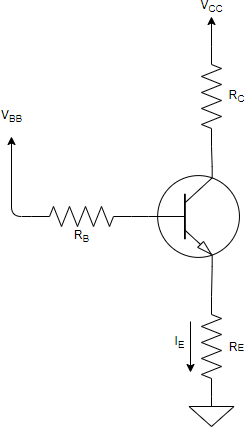This set of Electronic Devices and Circuits Multiple Choice Questions & Answers (MCQs) focuses on “The Alpha Cutoff Frequency”.
1. What is the function of an alpha cutoff frequency?
a) To simplify the circuit
b) To provide a non – linear output
c) To optimize the power
d) To provide steady current or voltage
View Answer
Explanation: The Q – point of a device is the direct current or voltage of a device when no input is applied. The alpha cutoff frequency is a part of the device with provides the steady current or voltage. It is designed by determining the necessary voltage and current levels across each resistor.
2. How many main types of alpha cutoff frequency are there in bipolar transistors?
a) 3
b) 4
c) 5
d) 6
View Answer
Explanation: There are five main type of biasing circuits. They are Fixed Bias, Collector – to – Base Bias, Voltage Divider Bias, Fixed Bias with Emitter Resistor and Emitter Bias. Each one of these have a different alpha cutoff frequency value.
3. Why do we require RE for a good stable alpha cutoff frequency?
a) To obtain a current IE sensitive to α and VBE
b) To obtain a current IB sensitive to α and VBE
c) To obtain a current IE insensitive to α and VBE
d) To obtain a current IB insensitive to α and VBE
View Answer
Explanation: The aim of having an alpha cutoff frequency is to maintain a stable current or voltage, regardless of other parameters changing. Hence, we need RE to get a stable IE current. Without RE the value of IE changes drastically with a small change in α.
4. In the circuit given below, assume VCC = 4V, VBB = 5V, VBE = 0.7V, RE = 3.3kΩ, RC = 10kΩ, RB = 40kΩ and α = 100. What is the current IE?

a) 1.388mA
b) 0.012mA
c) 10.47mA
d) 1.165mA
View Answer
Explanation: Given the values VCC = 4V, VBB = 5V, VBE = 0.7V, RE = 3.3kΩ, RC = 10kΩ, RB = 40kΩ and α = 100. To find the value of IE, we substitute the values in this equation:
IE = (VBB – VBE) / (RE + (RB / α + 1))
IE = (5 – 0.7) / (3.3 + (40 / 100 + 1))
IE = 4.3 / (3.3 + 0.396) = 1.388mA.
5. Why is it essential to stabilize the operating point of a circuit?
a) Thermal runaway, power efficiency, individual variations
b) Temperature dependency of IB, individual variations, power efficiency
c) Thermal runaway, Temperature dependency of IC, individual variations
d) Temperature dependency of IC, thermal runaway, cost efficiency
View Answer
Explanation: It is essential to stabilize the operating point of a circuit to prevent thermal runaway, temperature dependency of IC and individual variations. Thermal runaway occurs because of the self – destruction of an unstable transistor. Temperature dependency on IC causes major variations in IE. Individual variations of parameters such as α and VBE cause huge fluctuations in IE.
6. In an ideal stable self – alpha cutoff frequency, what should be the current IBwith respect to IC?
a) IB should be 20% of IC
b) IB should be 5% of IC
c) IB should be 10% of IC
d) IB should be 50% of IC
View Answer
Explanation: Ideally, the resistor values are designed in a way that the voltage drop across RE is approximately 10% of Vcc and IB should be 10% of Ic. Hence, stable self – alpha cutoff frequency work best at low power supply voltages.
7. What values of VBE and α would provide maximum stability?
a) VBE = 5V, α = 50
b) VBE = 4V, α = 100
c) VBE = 4.5V, α = 50
d) It is irrelevant
View Answer
Explanation: In a stable alpha cutoff frequency, the variations in the value of VBE and α do not affect the stability of the system. The current through the emitter remains unchanged. Hence, the values can vary without hampering the system.
8. What is the stability factor if RE = 8kΩ and RTH = 11kΩ during alpha cutoff frequency?
a) 1.335
b) 2.375
c) 1.727
d) 0.272
View Answer
Explanation: Stability factor is calculated by the following equation. On plugging in the given values RE = 8kΩ and RTH = 11kΩ, we get:
S = 1 + RTH / RE
S = 1 + 11 / 8 = 2.375.
9. Collector base feedback and emitter feedback combined together provide stability for self – alpha cutoff frequency.
a) True
b) False
View Answer
Explanation: Collector base feedback and emitter feedback combined provide stability for self – alpha cutoff frequency. This is because the emitter base junction is forward biased due to the voltage drop across RE.
10. Where does degeneration take place in a self – alpha cutoff frequency?
a) Across RB
b) Across RE
c) No degeneration occurs
d) Across RC
View Answer
Explanation: Degeneration or negative feedback occurs across RE which in turn stabilizes the fluctuations of current IE due to temperature changes and variations in VBE and α. In a stable alpha cutoff frequency, the variations in the value of VBE and α do not affect the stability of the system.
Sanfoundry Global Education & Learning Series – Electronic Devices and Circuits.
To practice all areas of Electronic Devices and Circuits, here is complete set of 1000+ Multiple Choice Questions and Answers.
If you find a mistake in question / option / answer, kindly take a screenshot and email to [email protected]
